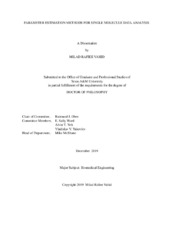| dc.contributor.advisor | Ober, Raimund | |
| dc.creator | Rafiee Vahid, Milad | |
| dc.date.accessioned | 2020-09-11T15:32:50Z | |
| dc.date.available | 2021-12-01T08:45:02Z | |
| dc.date.created | 2019-12 | |
| dc.date.issued | 2019-08-14 | |
| dc.date.submitted | December 2019 | |
| dc.identifier.uri | https://hdl.handle.net/1969.1/189164 | |
| dc.description.abstract | The advent of single molecule microscopy enabled the study of subcellular processes at the single molecule level, which was not possible before through conventional microscopy. This work makes contributions to parameter estimation in two important applications of single molecule microscopy: single molecule super-resolution microscopy and single molecule tracking. In single molecule super-resolution microscopy, images of subsets of stochastically photoactivated fluorophores are acquired over a sequence of frames. In order to construct a high-resolution image of the structures labeled by these fluorophores, the locations of the fluorophores are accurately estimated in each frame. In this study, we develop a novel state space-based fluorophore localization method from multi-emitter super-resolution images. An important property of our proposed method is its capability to distinguish very closely spaced molecules and estimate their locations accurately. Moreover, in contrast to most of the available methods that need prior knowledge about the number of emitting fluorophores in the image, our method determines this number using a procedure that utilizes a least-squares criterion.
Study of intercellular and intracellular trafficking processes of single molecules plays an important role in biological studies. Most of available single molecule trajectory parameter estimation methods are limited to Brownian motion and Gaussian measurement models. Another contribution of this research is the development of a stochastic framework to calculate the maximum likelihood estimates of the biophysical parameters of biomolecular interactions, e.g., drift and diffusion coefficients, where the motion of an object of interest, e.g., single molecule, is modeled more generally by stochastic differential equations, and the measurements are the detected photons emitted by the moving fluorescently labeled object using both ideal unpixelated and practical pixelated detectors, such as charge-coupled device (CCD) and electron multiplying CCD (EMCCD) cameras. More importantly, we develop a general framework to calculate the Cramér-Rao lower bound (CRLB), given by the inverse of the Fisher information matrix, for the estimation of unknown parameters and use it as a benchmark in the evaluation of the standard deviation of the estimates. | en |
| dc.format.mimetype | application/pdf | |
| dc.language.iso | en | |
| dc.subject | Fluorescence microscopy | en |
| dc.subject | Single molecule microscopy | en |
| dc.subject | Object tracking | en |
| dc.subject | Super-resolution microscopy | en |
| dc.subject | State Space | en |
| dc.subject | Stochastic differential equation | en |
| dc.subject | Maximum likelihood estimation | en |
| dc.subject | Fisher information matrix | en |
| dc.subject | Cramer-Rao lower bound | en |
| dc.subject | Kalman Filter | en |
| dc.subject | Monte Carlo approaches | en |
| dc.title | Parameter Estimation Methods for Single Molecule Data Analysis | en |
| dc.type | Thesis | en |
| thesis.degree.department | Biomedical Engineering | en |
| thesis.degree.discipline | Biomedical Engineering | en |
| thesis.degree.grantor | Texas A&M University | en |
| thesis.degree.name | Doctor of Philosophy | en |
| thesis.degree.level | Doctoral | en |
| dc.contributor.committeeMember | Yeh, Alvin | |
| dc.contributor.committeeMember | Yakovlev, Vladislav | |
| dc.contributor.committeeMember | Ward, Elizabeth Sally | |
| dc.type.material | text | en |
| dc.date.updated | 2020-09-11T15:32:51Z | |
| local.embargo.terms | 2021-12-01 | |
| local.etdauthor.orcid | 0000-0002-1785-0234 | |


